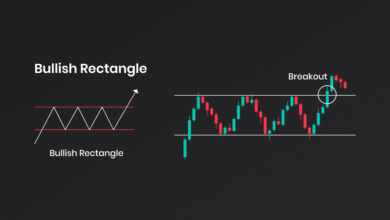Bearish
A bearish flag chart pattern is a technical analysis term used to describe a price formation that is typically seen after a strong directional move downward. This price formation is characterised by two declines separated by a brief consolidating retracement period. The flagpole forms at an almost vertical panic price drop, as bulls get blindsided by the sellers. After a bounce, the flag has parallel upper and lower trendlines, which form the flag. The initial sell-off comes to an end through some profit-taking and forms a tight range. This illustrates that there is still selling pressure present, although traders are also entering long positions looking for a reversal. During the consolidation, traders should be prepared to take action should price break down through the lower range level and/or make a new low. When the lower trendline breaks, it typically triggers panic sells as the downtrend resumes another leg down.
The Bearish Flag pattern is a continuation pattern that occurs during a downtrend. It suggests a brief consolidation period before the price continues its downward movement.
Formation:
– Prior Downtrend: The Bearish Flag pattern forms after a significant downward move, indicating a pause in selling pressure.
– Flagpole: The flagpole is a strong and steep downward price movement that precedes the pattern. It represents the initial impulsive phase of the downtrend.
– Flag: The flag portion of the pattern is a rectangular-shaped consolidation or retracement that follows the flagpole. It is characterized by price moving in a narrow range, often with declining volume. The flag is typically sloping upward, forming a channel bounded by two parallel trendlines.
Breakdown Confirmation:
– Bearish Breakdown: The Bearish Flag pattern is considered complete when the price breaks below the lower trendline of the flag channel. This breakdown confirms the continuation of the downtrend and is often accompanied by an increase in trading volume. Traders interpret this as a bearish signal to enter or maintain short positions.
Target:
– Price Projection: To estimate the potential price target after a breakdown, traders often measure the height of the flagpole (from the beginning of the flagpole to the high point of the flag) and project it downward from the breakdown point. This projection provides an approximate target for the continuation of the downtrend.
Bullish Flag
A bullish flag chart pattern in trading is a technical chart pattern that signals a likely increase in prices. It is characterised by a sharp countertrend (the flag) that follows a short-lived trend (the pole). This pattern resembles a flag with masts on either side and is followed by a substantial increase in the upward direction. The primary goal of a bull flag pattern is to enable traders to profit from the market’s current momentum, and after the pattern is spotted, traders use the volume indicator to predict the direction of the trend and determine the entry point. The breakout from this pattern often results in a powerful move higher, measuring the length of the prior flag pole. It is considered to be a formidable pattern to trade, as long as all elements are in place.
The Bullish Flag pattern is a continuation pattern that occurs during an uptrend. It suggests a temporary consolidation period before the price resumes its upward movement.
Formation:
– Prior Uptrend: The Bullish Flag pattern forms after a significant upward move, indicating a pause in buying pressure.
– Flagpole: The flagpole is a strong and steep upward price movement that precedes the pattern. It represents the initial impulsive phase of the uptrend.
– Flag: The flag portion of the pattern is a rectangular-shaped consolidation or retracement that follows the flagpole. It is characterized by price moving in a narrow range, often with declining volume. The flag is typically sloping downward, forming a channel bounded by two parallel trendlines.
Breakout Confirmation:
– Bullish Breakout: The Bullish Flag pattern is considered complete when the price breaks above the upper trendline of the flag channel. This breakout confirms the continuation of the uptrend and is often accompanied by an increase in trading volume. Traders interpret this as a bullish signal to enter or maintain long positions.
Target:
– Price Projection: To estimate the potential price target after a breakout, traders often measure the height of the flagpole (from the beginning of the flagpole to the low point of the flag) and project it upward from the breakout point. This projection provides an approximate target for the continuation of the uptrend.
It’s important to note that not all Flag patterns result in significant breakouts or breakdowns. Traders often use additional technical indicators or price confirmation to validate breakouts before making trading decisions. Furthermore, Flag patterns can occur on various timeframes and in different markets, allowing traders to apply them in their preferred trading instruments.


